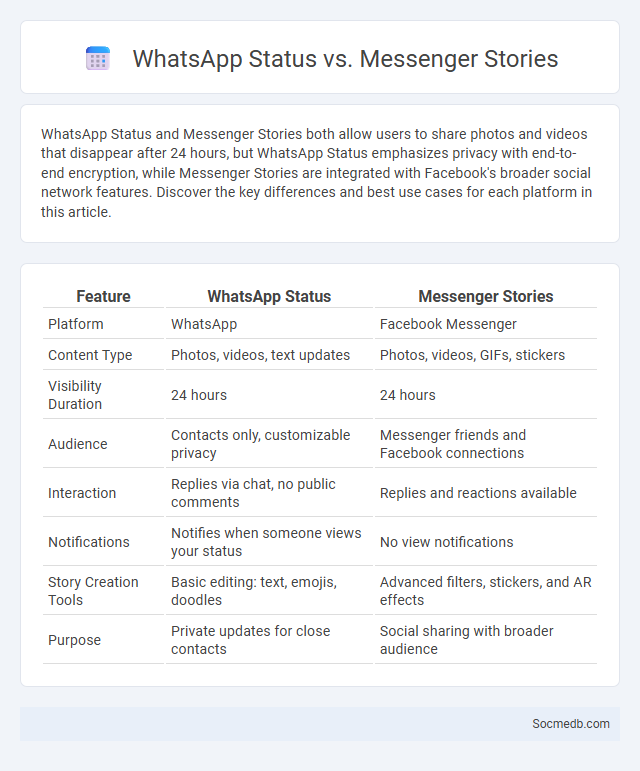
Photo illustration: WhatsApp Status vs Messenger Stories
WhatsApp Status and Messenger Stories both allow users to share photos and videos that disappear after 24 hours, but WhatsApp Status emphasizes privacy with end-to-end encryption, while Messenger Stories are integrated with Facebook's broader social network features. Discover the key differences and best use cases for each platform in this article.
Table of Comparison
| Feature | WhatsApp Status | Messenger Stories |
|---|---|---|
| Platform | Facebook Messenger | |
| Content Type | Photos, videos, text updates | Photos, videos, GIFs, stickers |
| Visibility Duration | 24 hours | 24 hours |
| Audience | Contacts only, customizable privacy | Messenger friends and Facebook connections |
| Interaction | Replies via chat, no public comments | Replies and reactions available |
| Notifications | Notifies when someone views your status | No view notifications |
| Story Creation Tools | Basic editing: text, emojis, doodles | Advanced filters, stickers, and AR effects |
| Purpose | Private updates for close contacts | Social sharing with broader audience |
Introduction to Social Media Status Features
Social media status features enable you to share real-time updates, thoughts, and moments with your network, fostering engagement and connectivity. These features include text posts, photos, videos, polls, and live streams, designed to capture and express your current mood or activity. Optimizing your status with relevant hashtags and tags increases visibility, driving more interaction and enhancing your online presence.
Understanding WhatsApp Status
WhatsApp Status allows you to share text, photos, videos, and GIFs that disappear after 24 hours, providing a dynamic way to communicate updates with your contacts. This feature uses end-to-end encryption, ensuring your shared content remains private and viewable only by selected friends or groups you choose. Understanding WhatsApp Status helps you leverage its full potential for engaging storytelling and maintaining closer connections with your network.
What Are Messenger Stories?
Messenger Stories are a feature within Facebook Messenger that allows users to share temporary photo or video updates visible to their contacts for 24 hours. These stories enable real-time communication with interactive elements such as stickers, text, and filters, enhancing personal expression. Messenger Stories integrate seamlessly with Facebook and Instagram, expanding social reach and engagement across platforms.
Defining Status Updates Across Platforms
Status updates on social media platforms function as real-time expressions of user thoughts, activities, or emotions, varying in format from text-based posts on Facebook and LinkedIn to image-centric stories on Instagram and Snapchat. Twitter emphasizes brevity with its character-limited tweets, while TikTok integrates status-like content into short-form videos, blending personal updates with entertainment. These platform-specific formats enable users to engage diverse audiences and tailor their personal or professional narratives effectively.
Key Differences Between WhatsApp Status and Messenger Stories
WhatsApp Status and Messenger Stories differ primarily in their privacy settings and audience reach; WhatsApp Status allows users to share updates visible only to contacts with customizable privacy controls, while Messenger Stories can be shared with Facebook friends and broader audiences depending on settings. WhatsApp Status content disappears after 24 hours, mirroring the ephemeral nature of Messenger Stories, but WhatsApp integrates status updates directly within a messaging-focused app, emphasizing personal connections. Messenger Stories offer enhanced interactive features like polls and links, aligning with Facebook's broader social networking ecosystem, whereas WhatsApp Status prioritizes simplicity and secure, private sharing.
Privacy and Audience Controls Compared
Privacy and audience controls on social media vary significantly across platforms, directly impacting how your personal information is shared and who can view your content. Features such as customizable privacy settings, audience selectors, and content visibility options give you the ability to limit access to your posts, protecting your data from unwanted viewers. Understanding and regularly adjusting these controls can enhance your online security and ensure your content reaches only the intended audience.
Multimedia Options and Creativity Tools
Social media platforms offer a diverse range of multimedia options including photos, videos, live streaming, and Stories, enabling users to create rich and engaging content. Advanced creativity tools like filters, augmented reality effects, stickers, and editing features enhance visual storytelling and user interaction. These multimedia capabilities drive higher audience engagement and enable brands to craft compelling narratives that stand out in crowded digital spaces.
User Engagement and Reach Statistics
User engagement on social media platforms averages 1.22% across all industries, with visual content boosting interaction rates by up to 65%. The average reach for organic posts is around 5.2% of total followers, while paid campaigns can increase reach by 40% to 60%. Maximizing Your content's appeal through targeted strategies enhances both engagement and reach, driving impactful audience growth.
Pros and Cons of Each Status Feature
Status features on social media platforms offer real-time sharing of updates, enhancing your ability to connect quickly with friends and followers, while promoting engagement through images, videos, and text. However, these features may also lead to privacy concerns due to the temporary nature of posts and the potential for oversharing, which can affect personal and professional boundaries. Understanding the balance between immediate communication benefits and the risks of exposure helps you use status features more effectively.
Choosing the Right Status Platform for You
Selecting the right social media platform depends on your goals, target audience, and content style. Platforms like Instagram excel for visual storytelling, while LinkedIn caters to professional networking and industry updates. Understanding each platform's unique features ensures your status reaches and engages the audience most relevant to your message.
 socmedb.com
socmedb.com